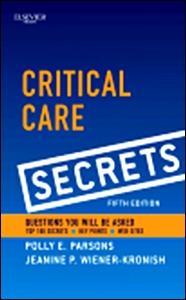Critical Care Secrets,5/e
This best-selling volume in The Secrets Series® is back in an exciting, fully updated 4th Edition! You'll find all of
the features you rely on the Secrets forsuch as a question-and-answer format · bulleted lists · mnemonics · "Key
Points" boxes · and tips from the authors.
1. General Approach to the Critically Ill Patient
2. General Approach to Trauma victims
3. Cardiopulmonary Resuscitation
4. Assessments of Oxygenation
5. Pulse Oximetry, Capnography, and Blood Gas Analysis
6. Hemodynamic Monitoring
7. Fluid Therapy
8. Nutrition in Critically Ill Patients
9. Mechanical Ventilation/Non-invasive
10. Discontinuation of Mechanical Ventilation
11. Arterial and Central Venous Catheters
12. Ultrasound in the Intensive Care Unit
13. Extracorporeal Membrane Oxygenator (ECMO)
14. Tracheal Intubation and Airway Management
15. Tracheotomy and Upper Airway Obstruction
16. Chest Tubes
17. Bronchoscopy
18. Pacemakers and Defibrillators
19. Circulatory Assist Devices
20. Acute Bacterial Pneumonia
21. Asthma
22. Chronic Obstructive Pulmonary Disease
23. Cor Pulmonale
24. Acute Respiratory Failure/ARDS and Acute Chest Syndrome/ALI
25. Hemoptysis
26. Venous Thromboembolism and Fat Embolism
27. Heart Failure and Valvular Heart Disease
28. Acute Myocardial Infarction
29. Dysrhythmias and Tachyarrhythmias
30. Aortic Dissection
31. Pericardial Disease (Pericarditis and Pericardial Tamponade)
32. Sepsis, Severe Sepsis Syndrome, and Septic Shock
33. Endocarditis
34. Meningitis and Encephalitis in the Intensive Care Unit
35. Disseminated Fungal Infections
36. Multidrug-Resistant Bacteria
37. Bioterrorism
38. Skin and Soft Tissue Infections
39. H1N1/Influenza
40. Immunocompromised Host
41. Hypertension
42. Acute Renal Failure
43. Renal Replacement Therapy and Rhabdomyolysis
44. Hypokalemia and Hyperkalemia
45. Hyponatremia and Hypernatremia
46. Gastrointestinal Bleeding in the Critically Ill Patient
47. Acute Pancreatitis
48. Hepatitis and Cirrhosis
49. Acute Abdomen/Peritonitis
50. Diabetic Ketoacidosis and Hyperglycemic/Hyperosmolar Syndrome
51. Management of Hyperglycemia in the Critically Ill
52. Adrenal Insufficiency in the Intensive Care Unit
53. Thyroid Disease in the Intensive Care Unit
54. Blood Products and Coagulation
55. Thrombocytopenia and Platelets
56. Disseminated Intravascular Coagulation
57. Oncologic Emergencies (Including Hypercalcemia)
58. Rheumatologic Disease in the Intensive Care Unit
59. Coma
60. Brain Death
61. Status Epilepticus
62. Stroke
63. Guillain-Barre Syndrome
64. Myasthenia Gravis
65. Alcohol Withdrawal
66. Burns and Frostbite
67. Pneumothorax
68. Flail Chest and Pulmonary Contusion
69. Cardiac Trauma
70. Liver and Heart Transplantation
71. Use of Paralytic Agents in the Intensive Care Unit
72. Pain Management in the Intensive Care Unit
73. Sedation, Analgesia, and Delirium
74. Disaster Medicine
75. Allergy and Anaphylaxis
76. Hypothermia
77. Heat Stroke
78. General Toxicology and Toxidromes
79. Analgesics and Antidepressants
80. Toxic Alcohol Poisoning
81. Poisoning by Cardiovascular Drugs
82. Neuroleptic Malignant Syndrome
83. Care of the Critically Ill Pregnant Patient
84. Ethics
85. Palliative Care
86. Organ Donation
87. ICU Organization, Management, and Value
88. Quality Assurance and Patient Safety in the Intensive Care Unit
89. Scoring Systems for Comparison of Disease Severity in ICU Patients


